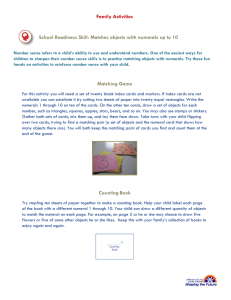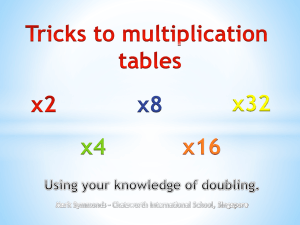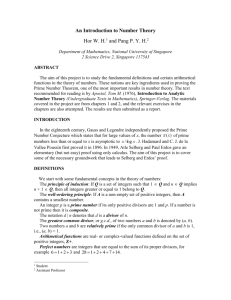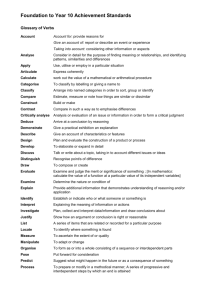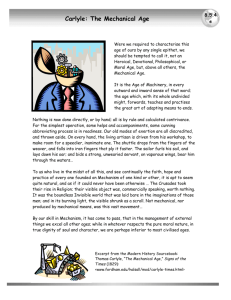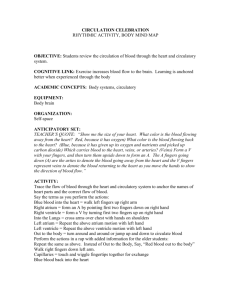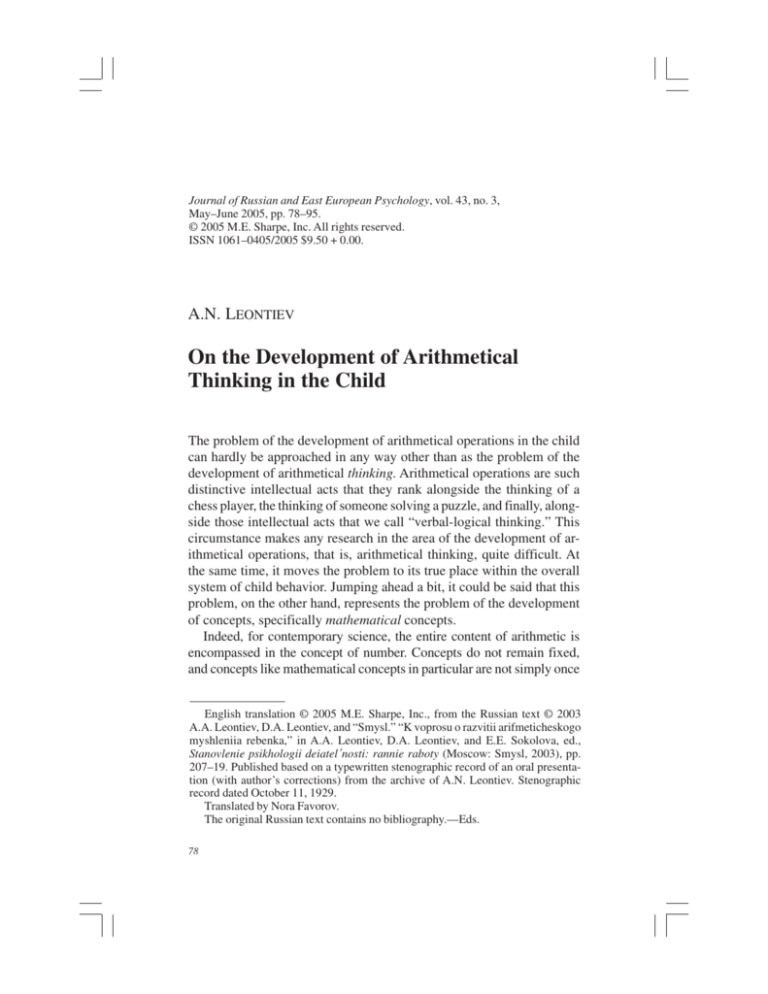
78
JOURNAL OF RUSSIAN AND EAST EUROPEAN PSYCHOLOGY
Journal of Russian and East European Psychology, vol. 43, no. 3,
May–June 2005, pp. 78–95.
© 2005 M.E. Sharpe, Inc. All rights reserved.
ISSN 1061–0405/2005 $9.50 + 0.00.
A.N. LEONTIEV
On the Development of Arithmetical
Thinking in the Child
The problem of the development of arithmetical operations in the child
can hardly be approached in any way other than as the problem of the
development of arithmetical thinking. Arithmetical operations are such
distinctive intellectual acts that they rank alongside the thinking of a
chess player, the thinking of someone solving a puzzle, and finally, alongside those intellectual acts that we call “verbal-logical thinking.” This
circumstance makes any research in the area of the development of arithmetical operations, that is, arithmetical thinking, quite difficult. At
the same time, it moves the problem to its true place within the overall
system of child behavior. Jumping ahead a bit, it could be said that this
problem, on the other hand, represents the problem of the development
of concepts, specifically mathematical concepts.
Indeed, for contemporary science, the entire content of arithmetic is
encompassed in the concept of number. Concepts do not remain fixed,
and concepts like mathematical concepts in particular are not simply once
English translation © 2005 M.E. Sharpe, Inc., from the Russian text © 2003
A.A. Leontiev, D.A. Leontiev, and “Smysl.” “K voprosu o razvitii arifmeticheskogo
myshleniia rebenka,” in A.A. Leontiev, D.A. Leontiev, and E.E. Sokolova, ed.,
Stanovlenie psikhologii deiatel’nosti: rannie raboty (Moscow: Smysl, 2003), pp.
207–19. Published based on a typewritten stenographic record of an oral presentation (with author’s corrections) from the archive of A.N. Leontiev. Stenographic
record dated October 11, 1929.
Translated by Nora Favorov.
The original Russian text contains no bibliography.—Eds.
78
MAY–JUNE 2005
79
and for all completed products of the elementary process of abstraction;
they continue to develop in accordance with how they are used as a
certain means, and in this sense they constantly become more complex
and richer as the quantity and complexity of the operations into which
they enter become more numerous and complex.
We feel that this circumstance must be kept in mind from the start, as
we will analyze what follows from the perspective of the development
of the very concept of number, that is, the refinement of the means by
which various sorts of calculations and arithmetical operations are made
possible.
When the formation of concepts is discussed within psychology, it is
not unusual for this process to be thought of as nothing more than the
abstraction of some sign, and that is all there is to it. Whether or not this
is true of so-called general ideas, such an understanding must be decisively rejected when it comes to arithmetical concepts. In formulating
the problem of the development of arithmetical operations, it is hardly
possible to embark on an attempt to analyze the development of these
operations as those relying on concepts that are merely the product of
initial abstraction.
Before turning to an analysis of the process by which arithmetical
thinking develops, first it must be determined where exactly arithmetical operations begin, and second, in what direction these operations develop. In other words, the first question that must be posed is: what will
we understand when we speak about arithmetical thought? The theoretical foundations of modern arithmetical pedagogy are vague, specifically because this fundamental question has not been resolved with
sufficient clarity—the point at which the development of arithmetical
thought in the literal sense of the word begins—has not been identified.
In turn, this well-known confusion and difficulty in determining the point
at which arithmetical thought begins to develop, are tied, it seems to us,
to the fact that a general theory of psychological development has not
been sufficiently developed. It was only after the proposition became
primary within child psychology that we also encounter alongside the
organic development of the child—and we must distinguish this—historical development. Only from the moment that L.S. Vygotsky first
established this proposition were we first provided the possibility of
attaining a true understanding of the essence of the process of the development of arithmetical operations. At the same time, we were first provided an opportunity to determine with complete exactitude the point at
80
JOURNAL OF RUSSIAN AND EAST EUROPEAN PSYCHOLOGY
which arithmetical thought begins in the literal sense of the word. In
determining the point at which arithmetical thought begins to develop,
theories of the development of higher behavior and of the historical development of the child also resolve a whole array of the most confusing
issues that arise in connection with analyzing the process of a child’s
mastery of his first computational operations. In particular, as L.S.
Vygotsky demonstrated, this theory resolves the methodological dispute that arose in connection with the question of what lies at the beginning of the development of arithmetical operations.1 As is well-known,
the essence of this dispute was that one viewpoint regarded the development of arithmetical operations in the child as relying directly on the
natural perception of certain groups of numbers, and that with the development of this direct perception of groups of numbers, the child approaches true arithmetical thinking and operations. Proponents of the
opposite view attempted to demonstrate that the process of child development is not dependent not on these elementary perceptions, but develops directly from the first attempts at counting and counting
operations. If we take a closer look at the content of this dispute, then
perhaps we will be able to identify certain additional propositions that
we will be able to apply. Like the overall development of higher behavior, the development of arithmetical operations takes place in known
stages. It is central to this process that at a certain step in it, functions
that were, or that had appeared as, natural functions, take on a new,
more complex form and are transformed into mediating functions that
presume a second series of stimuli/means. On the other hand, these
mediated functions themselves can change as they develop and appear
at times in the form of acts that rely on external stimulating media and at
other times in the form of acts that do not rely on external media in
which their role is carried out by corresponding internal elements.
These propositions are undoubtedly the key to the question raised in
the above-mentioned methodological discussion. It becomes absolutely
clear from this perspective that the essence of one type of arithmetic,
called Lai arithmetic, is founded on the direct perception of numerical
figures. In fact, in operations with Bourne’s figures, as is shown by even
the most superficial analysis, there is no actual arithmetical operation,
most likely because actions with these figures are not mediated actions.
These operations are based on the “natural arithmetic” of the child. Here,
we do not have arithmetical thinking.
MAY–JUNE 2005
81
Experimental research concerned with the arithmetic of Bourne’s
figures shows that such natural arithmetic is capable of being developed, and furthermore, that in its development it can sometimes achieve
exceptional effectiveness. Sometimes its development even leads to results that are obviously better than those of development based on any
other techniques. Nevertheless, as far as we know, Lai himself was
unable to demonstrate the transition from this natural arithmetic to arithmetic in the literal sense of the word, which operates a set series of
signs, or concepts. This is why Lai himself, in order to explain the possibilities of subsequent development and of the transition from these
natural acts to mediated acts, should have accepted the proposition that
mathematical knowledge is by nature a priori knowledge. And in fact,
only if we accept that proposition will there be a possibility of transition
within the child from the sensory and direct perception of number relations to operations with these number groups appearing as signs exhibiting a series of completely fixed properties and characteristics that are
understandable from the perspective of Lai’s psychology.
Of course, one must not think that elementary arithmetical development in the child relies on the ready concept of number, that is, that
operations in a child develop from his understanding of the properties of
numbers. In this respect, P.P. Blonskii is completely correct in stating
that to think this would be like teaching a child arithmetic, starting
with fractions, or perhaps even—we will add—starting with the table
of logarithms. . . . On the other hand, the view that associates the development of arithmetic with processes of elementary abstraction is also
not entirely correct, because it sees arithmetic developing out of elementary general ideas about quantity.
The ability to distinguish quantity as a known characteristic is obviously an essential condition for arithmetical operations; nonetheless,
this distinction alone does not, of course, constitute an arithmetical operation. Just as it has been possible to identify a reaction in animals to
primary colors, and even to relations between these colors, it has also
been possible to identify in them a reaction to quantitative characteristics. In other words, arithmetical operations do not emerge when primary, elementary abstraction of the characteristic of quantity emerges.
From our perspective, arithmetical operations begin only at the point
where Lai’s natural arithmetic gives way to mediated operations with quantities. From the general theory of historical development we know that
82
JOURNAL OF RUSSIAN AND EAST EUROPEAN PSYCHOLOGY
these mediated operations pass through two basic stages of development:
the stage of externally mediated acts and the stage of acts mediated with
the help of internal elements. In this respect, the development of arithmetical operations is no exception. Here, of course, significantly more
complex relations exist between externally internally mediated acts.
Nonetheless, here too in the basic features, we can see both these phases
as being perfectly distinct, following the usual sequence: first the phase
of externally mediated acts, and only then the stage of acts mediated
internally. In support of this hypothesis, we could offer a whole series of
examples, both ethnopsychological—from phylogenesis—and examples
from ontogenesis.
In particular, one can point out the custom in primitive tribes of counting on their fingers or using very elementary tallying devices [e.g.,
notched sticks]. If we examine the development of arithmetical operations in the history of human development, first we encounter such devices as tallies. Later, we find more complex methods that rely, for
example, on counting using an abacus, which is nothing but a partitioned board, where stones are placed and counted. Later we encounter
certain improvements in this abacus: on the one hand, there is the Roman abacus, where the stones are already attached to the board. This
was followed by the appearance of similar varieties that were close to
the Russian abacus. The Chinese had a more advanced form of the abacus, the so-called suan pan, a counting device founded in essence on the
same principle as the Russian abacus. Finally, in relatively recent times,
during the twelfth century, the so-called bank appears, from which moneychanging offices took their name, that is, counting benches—a table that
has improved graphs for even more efficient commercial computations.
In all of these cases, we have examples of externally mediated counting
operations.
When the development of arithmetical operations advances to the
stage of operating with numbers and graphic symbols, that is, when operations are converted to those involving moving, shifting, and transposing objects into graphic operations, and where moving is replaced
by notation. Even at this stage, for a very long time, the notation itself
remained a purely external operation. In India, we encounter a very curious method of multiplication that was adopted in Europe at the beginning of the middle ages. The method was as follows: the multiplicand is
written on top, forming a first row of numbers, and the multiplier is
written to the right in a vertical row (see Figure 1).
MAY–JUNE 2005
83
[Figure 1. Example of an Early Method of Multiplication]
Each digit of the multiplicand is multiplied by each digit of the multiplier, with the resulting products (in our example there are 9 products)
written in the boxes so that each product is opposite the digit whose
multiplication produced it. In order to reach the final result, we simply
have to add the digits diagonally. This method is remarkable in that no
digits have to be retained in the mind; the entire operation relies on
purely external procedures.
We observe exactly the same thing in children studying arithmetic.
Initially, a child divides using a technique that cuts no corners, without
any canceling or “holding in mind.” In the same way, in adding multiple-digit numbers, any digit beyond the ones place is not initially held in
mind but is carried over to the top, where it is denoted by the corresponding number. Only later, under the influence of subsequent training, does a
child switch to calculation methods that require holding a number in mind,
that is, operations aided by both external and internal signs.
We must repeat that in arithmetical thought, it is exceptionally difficult to set the dividing lines between operations taking place with external signs and those taking place with the help of internal signs. This
issue is extremely complex. For this reason we will not go into it here in
any great detail; in any event, we can come to the simple conclusion that
before an arithmetical operation can be completed using internal signs,
it must be supported by external signs. This is shown in both historical
data and observation of children, as well as in experimental findings
available to us, which are especially convincing. In the pedagogical
84
JOURNAL OF RUSSIAN AND EAST EUROPEAN PSYCHOLOGY
Table 1
[Accuracy of Children’s Counting with and Without Using Their Fingers]
Subject number
Number of mistakes
while counting on fingers
Number of mistakes when
subject unable to move fingers
1
2
3
4
5
6
7
8
9
0
1
3
0
0
0
3
0
1
1
6
6
2
6
3
7
1
4
experience of the Medical Pedagogical Clinic, it was noted within a
group of mentally retarded children that they were exceptionally persistent in holding to the method of addition using their fingers. This presented significant problems during attempts to force them to switch to
some other method, particularly to solve oral problems, without resorting to counting with their fingers or using markings with a pencil—that
is, to a system using tallies to count the numbers. When we attempted to
verify these observations, even the most superficial ones, we determined
that in truth, even given the simplest addition operations, a majority of
the children bent their fingers to count them. That is, when counting, the
children turned to external methods, and it was extremely difficult to
exclude these external methods. Sometimes a child did this in such a
way that it was barely noticeable, so counting on the fingers is not easy
to detect.
In order to verify the role fingers play in the counting performed by
mentally retarded children, we used a very simple method to completely
rule out counting on the fingers among our child subjects from this
group—we filled their hands by giving them enough large objects to
hold so that they were unable to manipulate their hands in any way. In
the first instance, a saucer was used with the child holding it from the
top in such a way that any movement of the fingers would have caused
the saucer to fall. After this, we simply took the child’s fingers in our
hands and asked him to perform the same operations that he had managed to do counting orally when his fingers were free. The results are
presented in Table 1.
If we calculate the average quantities, we see that the number of
MAY–JUNE 2005
85
mistakes made when the children’s fingers were occupied was slightly
more than four times greater than the number of mistakes made when
their fingers were used for counting. It can thus be concluded—especially
considering the fact that the majority of children solved problems without error when using their fingers—that counting among our children
occurs only when a child is able to turn to a known external method.
This observation leads us to the following practical supposition, which
is important to our work: in order to show how arithmetical operations
occur at the earliest stages of development, we need only show how the
development of this operation takes place as an operation relying on
external means.
Here we must again go back a bit to the question of precisely where
arithmetical operations begin. If we consider even roughly what arithmetical operations consist of, first we must establish that any arithmetical operation deals with an aggregate that can be broken down into a set
of units.
The very first question can therefore be considered answered, on the
basis of the general propositions that we have: it is clear that the fundamental stage in the development of behavior related to multiplicity is the
natural perception of quantity, that is, a perception that, in the final analysis, can be used only in problems of immediate estimation. As we will see,
this perception can be associated with the naming of quantitative features
and of the quantity itself. The construction of a natural series of numbers,
that is, the ability to name an ordinal series of numbers presents a more
complex case. Finally, we have another line of this development—the
development of the quantitative acts themselves.
Here, the following questions must be raised, first and foremost :
how does a natural series of numbers arise and—most important—do
we have in this ability to name a numeral the beginning of arithmetical
thinking.
The emergence of ordinal counting undoubtedly presumes that the
process of elementary abstraction is already taking place, and quantity
as a general property has already been distinguished. We can then see
that this initial elementary abstraction does not emerge immediately;
we do not immediately have formations of series of abstract values in
our understanding of the word. It is known that many primitive tribes
use different words for counting different objects, that is, they build
several natural series. These specific series are based on the ideas that
86
JOURNAL OF RUSSIAN AND EAST EUROPEAN PSYCHOLOGY
Lévy-Bruhl calls “ensembles-nombres.” However it is not necessary to
understand these separate natural sequences entirely as a concrete series. If we look closely at what appears at first glance to be a distinct and
very concrete series, we will be easily convinced that in these series, a
certain general principle is observed. It is not difficult to see this as well
in a table by Boas. We see that while there is one count for round objects
and another for animate objects, between the mutually corresponding
numerals there is nonetheless an obvious phonetic similarity. This demonstrates that a natural series of this sort, while remaining concrete, still
contains certain elements presuming a level of abstraction.
At this point we are interested in a fundamental question: is this enumeration of objects—naming of the primitive ordinal series—an arithmetical operation in the true sense of the word? Do we have here a kind
of mediated operation? The relatively modest ethnographic materials
that we have at our disposal indicate circumstances that allow us to
answer this question with some degree of certainty. The first thing that
is striking in the study of primitives is their exceptional poorness of
numerals. One researcher (Dr. Crawford), who studied Australian languages and investigated approximately thirty Australian dialects, indicates that evidently, not one tribe of this vast continent is able to name a
value above 4. In essence, only with the development of finger counting
and using tallies does the natural series begin to develop. Thus, the natural series is not only a precondition for the development of subsequent
arithmetical operations, but at the same time, it is a result of this development. It seems to me that this circumstance has great significance. If,
however, we follow the development of the natural series further, as a
result of the development of calculation using, for instance, one’s fingers, this development, at least at its inception, does not presume any
arithmetical operations in their true sense. Any time that we encounter
such a natural series, we do not have much calculation or enumeration,
such as the naming of concrete numerical ideas.
Indeed, how does such a natural series—which may be extended quite
far and may develop as the result of primitive naming operations—form?
For instance, the natives of Murray Island count in the following way:
(1) little finger, (2) ring finger, (3) middle finger, (4) index finger,
(5) thumb, (6) wrist, (7) back of the wrist, (8) long bone (inside part of
the elbow), (9) outside the elbow, (10) shoulder, (11) armpit, (12) supraclavicular fossa, (13) the left side of the chest, (14) the navel, (15) top of
MAY–JUNE 2005
87
the chest, (16) throat, (17) second side of the chest, and so forth. If we
examine the structure of other natural series, we discover another element: the naming of such a natural series often cannot be limited to
words. For instance, we know that in some tribes there is a structure
consisting of a natural series where one and the same numeral can signify different quantities depending on the gesture accompanying the given
word; for instance, the word “doro,” when not accompanied by a gesture, signifies to the inhabitants of the Musa River 2, 3, 4, 19, 20, and 21
(McGregor).
Thus, we can speak of this natural series as a series of concrete numerals rather than as series of numbers in the true sense of the word. In this
instance, number is not an arithmetical sign; it is not thought of as something equal in and of itself or as something that can make up a number and
can be divided into numbers; it does not have those fundamental properties that transform a concrete numeral into an actual number.
In generalizing this material I thought we would be able to reach the
conclusion that a natural series, or, more precisely, the naming of a natural
series at this stage of development, undoubtedly is still not an arithmetical operation, and that it will only turn into a true arithmetical operation
at much higher stages of development of the natural series—that is, fundamentally speaking, only when discoveries on par with the discovery
contained in Archimedes’ Sand Calculator [Psammit], when the fundamental property of this series is identified—to be infinitely continued,
when this series is the result of the consciousness of a distinct system—
namely, a system of numbers.
If we now turn our attention to acts carried out by using fingers or
tallies or some external means, here too there is reason to ask: where
does an arithmetical operation in the literal sense of the word begin, that
is, where does natural arithmetic make way for mediated arithmetical
acts that are carried out using a defined means—by using defined and
specific signs. First of all, I will allow myself to point to the fact that
using one’s fingers is not always a method of calculation; sometimes
using fingers is just a means of expression, or, more precisely, a means
of naming quantities.
Here is what one observer (Gayton) had to say about the counting of
the Damar [people]:
If you ask them how many days’ journey it is to a certain place, their lack
of knowledge of any numerical concepts becomes impossible to compre-
88
JOURNAL OF RUSSIAN AND EAST EUROPEAN PSYCHOLOGY
hend. No matter how many numbers might exist in their language, in
practice they obviously use no numbers above three. When they want to
express “four,” they turn to their fingers, which for them are as terrifying
an instrument of calculation as a nonius [or vernier] is to an English schoolchild. The Damar find it extremely difficult to go beyond five because
they are left with no free hand with which to grasp a finger, which would,
so to speak, play the role of a needed numeral. Nevertheless, they rarely
lose any bulls: the way they discover that one is lost is not by noting a
reduction in the number of cattle in the herd, but through the absence of
some familiar figure. When they engage in trade, each sheep must be
paid for separately. So, for instance, if the trade price of a sheep is two
packets of tobacco, a Damar, of course, will have great difficulty if two
sheep are taken, and he is given four packets. I once did this and observed
how my seller set aside two separate packets and looked through them at
one of the sheep he was selling. Convinced that he had been honestly
paid and finding to his surprise in his hands he still held exactly two
packets in payment for the second sheep, he began to be tormented by
doubt. To correctly complete the transaction it appeared that two cycles
had to take place, and so he again turned to the first pair of packets; then
his mind became vague and confused: he pondered one sheep and another and finally, refused the transaction until two packets were placed in
his hands and one sheep was taken away, and then another two packets
were given and another sheep was taken.
We present this long citation because it appears to give a clear picture
of the proposition that has just been advanced: the Damar use their fingers simply to indicate quantity. However, when faced with the problem
of performing an operation with quantities, that is, when faced with, for
example, a problem as simple as placing two fingers next to another two
fingers and indicating the four fingers as the price that must be paid for
two sheep, such an operation is beyond their capabilities. Naturally, for
people at exceptionally low stages of psychological development, the
simple showing of fingers, simply naming a certain quantity using the
fingers is already a significant step forward. On the other hand, this
naming a quantity by using fingers is the natural prerequisite that leads
to the actual calculating operations using fingers, tallies, and so on.
Just how difficult it is to one’s fingers can be seen in another observation that I will also permit myself to reproduce in full. Referring to calculations by Eskimos, one researcher indicates the following:
They manage calculations with such difficulty that for many of them counting to ten is a lot of work, and to fifteen an impossibility. Dr. Re . . .
MAY–JUNE 2005
89
confirms that if the father of a family is asked how many children he has,
answering will often cause him great difficulty. After counting on his
fingers for some time, he will probably still have to consult his wife, and
both spouses may arrive at different answers, even if there are only four
or five children. (J. Lubbock)
Perhaps there is a certain exaggeration here, but it appears to us that it
is beyond doubt nevertheless that using fingers is not always applied to
the execution of set arithmetical operations. An Eskimo may be able to
indicate four and five and even much higher sums, but when he has to
show the number of fingers that correspond to a quantity of children, he
is in great difficulty. The question arises whether that primary operation
of showing fingers—that unique manner of speech that uses gestures—
constitutes what we could call a true arithmetical operation? From our
perspective and in the examples presented we have yet to discover any
arithmetical operation at all. Here arithmetic remains at the stage of a
natural process. However, the very appearance of numbers, the moment
when numbers, associated with a gesture, appear in the language, constitutes the prerequisite for such operations to emerge. This is very important. In those very same Damar, whose example we presented to show
that the use of fingers is not always tied to a set of arithmetical operations, we have an actual calculating process using the fingers. The example of the sale of a heifer is well known (etc.).
In this case, one’s fingers carry out a new role; they serve as a means
of comparing two quantities. True, the author here indicates that if a
Damar places not a packet but a half-packet of tobacco under each finger, he will be completely satisfied with the operation, and only after
some time will he be able to figure out that he has been deceived. Nonetheless, here we encounter for the first time the use of fingers as a means
of calculation and as a means of comparing quantities.
Analogous operations are noted in Lévy-Bruhl, who is better known
than other researchers in the psychology of primitive tribes. I will remind the reader of one of his examples related to a tax collector who, in
order to compute the quantity of tax units, put aside a piece of paper
corresponding to each finger and then left the aggregate as the results of
his calculation. Here, fingers or tallies function toward a specific goal,
in this case the goal of adding certain quantities.
Undoubtedly, these operations are exceptionally closely tied to the
development of the natural series itself.
The direction taken by the very development of the natural series also
90
JOURNAL OF RUSSIAN AND EAST EUROPEAN PSYCHOLOGY
becomes clear: it primarily follows the line of development of the ordinal
system of numbering. In this sense the move toward numerals that rely
on gesture plays a major role: showing with the help of fingers and using certain primitive forms of tallying. We find numerical series of another order in Lévy-Bruhl’s examples where we have the little finger,
the ring finger (etc.), but then we have the hand, then two hands, then
“the man is used as a calculator” up to what would correspond to twenty.
Here Levy-Bruhl already has a detailed system of signs that are essentially actual numbers, that is, when we speak of “the man being used as
a calculator,” this includes two arms and two legs; it is a quantity that
has a number equal to oneself, broken down into numbers; here we encounter a sign that is the concept of a number, an arithmetical sign.
We have something else entirely in the natural series that I introduced
earlier. First, when we speak of “shoulder” or “left chest,” we are barely
able to see that this is a numeral characterizing a certain quantity. Finally, we are shown languages that have numbers for two–three, let us
say, Australian languages, that have simply one, two (etc.).
Of course, it appears that this series can also be continued infinitely,
and that it already creates a system. However, it seems to me—and this
stems from a closer analysis of information received from several itinerant researchers—that to a significant degree we ourselves introduce this
system of counting. There are a number of cases in which in response
to, “How many objects are here?” “Here are some objects, count how
many are there,” members of primitive tribes simply stated several numerals at random, that is, they blurted out a number of words, indicating
two, two, two, without the slightest interest in how this mechanically
formed complex number corresponds to reality. We encounter this mechanical numbering extremely early. Do we have the right, however, to
view this possible increase in a series of numerals, presuming there are
features of a system in it, that is, to understand it by means of analogy to
our own numerical series? I would like to draw a fundamental conclusion that, from my perspective, can be deduced from everything that I
said above: we are standing, it seems to me, before the undisputed fact
that mere participation in processes using quantities of fingers or tallying devices does not show, in essence, that we are dealing here with
natural arithmetic, but arithmetic in the true sense of the word, that is,
with operations that we could signify as mediated calculating operations. A calculational operation can be immediate, if the use of one’s
fingers is only to name quantities.
MAY–JUNE 2005
91
In this case, the use of fingers seems to me to be an example of speech
using gestures. Perhaps, from this gesture that participates in speech a
numeral is formed—and indeed it must be this way—but this numeral is
still not a number, that is, the specific sign of an arithmetical operation.
It appears to me that the participation of fingers in operations with quantities at this specific stage of their development is extremely unique; this
means that the relation between the function carried out in this case by
the fingers, connected to the function that they carry out subsequently,
can be viewed as the relation between a pre-intellectual operation and
an actual intellectual operation. What we have in these numerals, in
these finger operations and what is manifested before the development
of actual computational signs are merely prerequisites for the development of arithmetical operations, but we do not have arithmetical operations as such at this point. They begin only when the numeral becomes a
number, that is, when it begins to have corresponding and specific features. To use another formulation, I could put it this way: we are not
counting when we are listing or directly perceiving quantity. To have an
arithmetical operation one must have an arithmetical sign, a sign that
originates not from the initial abstraction resulting in a numeral, which
provides only the possibility of naming features, but one that arises first
and foremost from operations with these quantities. From here also
emerged the particular framing of the question generated in our experiments. It seems to me that the task of studying arithmetical thinking lies
in bringing the process of the emergence of the actual arithmetical sign
closer to oneself, that is, in trying to discover how the numeral, as a
means of naming a certain abstract feature, is transformed into a means
of executing a series of arithmetical operations.
Of course, the very naming, the listing, the notation or indication of
quantity using fingers is already a mediated operation, and in this sense
there is no distinction between it and actual calculations; however, along
with these general features inherent in all higher behavior, it seems to me
that we must also investigate the specific features that distinguish different higher functions from one another—the characteristic features of the
means that lie at the foundation of these functions and that form them. In
this sense our task is to indicate exactly where actual arithmetical operations begin, that is, where a sign—serving as a sign of indication, communication, or even memorization or notation—turns into a sign of calculation,
where that sign turns into a means of arithmetical thought.
The subject we chose for our experimental observations was the pro-
92
JOURNAL OF RUSSIAN AND EAST EUROPEAN PSYCHOLOGY
cess by which mentally retarded children master addition. I believe that
the choice of this operation was rather felicitous, specifically because it
is the fundamental operation with numbers, and not only in historical
terms, but from the perspective of theoretical arithmetic. This elementary arithmetical calculating operation is the operation that forms the
initial concept of the number. It gives birth to the arithmetical sign that
is truly able to serve as a means of calculation.
The method that we used in our study was extremely simple. Taking
a certain group of mentally retarded child (the “second” group, named
for their special educational school), we traced, first, how the elementary operation of addition up to the sum of twenty proceeds in mentally
retarded children using the means that they have at hand. Second, we
tried to trace how this operation proceeded when we deprived the children of these means, and finally, in cases where we told them about
different approaches to the operation.
I will present only the most fundamental results.
First, we acted just as any school teacher would act: we had our children execute an arithmetical operation using a number and had them
solve an ordinary class problem, which the children in the actual class
solved. It was already evident, based on what I referred to earlier regarding the connection between arithmetical operations of mentally retarded children and external media, that we were not dealing here with
an actual arithmetical operation. What we really had was just a writing
down of the results, the subsequent expression of results already reached.
The child writes down the example, then he or she recalculates it, using
a separate sheet of paper, with the result that has been reached, and
translates it into the language of abstract numbers, writing down the
answer. Here, in essence, the method of counting is not adequate to the
means that we offered the child.
But how do children’s addition operations proceed when we let them
use their fingers, and what does our experimentation with these techniques consist of?
Here is what we saw in children whose finger counting was the most
developed: they had to add five and six (etc.).
An approach that corresponds to this calculation using tallies is as
follows: the child takes a piece of paper that we give him and produces
the same operation using tally markings that he produces using fingers.
The process is completely clear.
But here I would like to ask the very same question about whether or
MAY–JUNE 2005
93
not this is an arithmetical operation in the true sense; are we encountering here the rudiments of an elementary form of arithmetical thought?
Is one operation being substituted for another? Do we have here simple
listing, simple naming? To be sure, the operation is already rather complex, but nevertheless it seems to me that it still cannot serve as an entirely distinct example of a full-scale arithmetical operation. We have
the making of marks that correspond to the names of numbers, that is, a
case of deciphering the numerals we pronounce, and we also have the
primary means of expressing the quantity of objects that are before the
child. The next stage, which was very easy to observe in our experimental group, is of considerably greater interest. If we selected certain quantities, we noticed that instead of adding five fingers in turn, the child
immediately bent his entire wrist, and so forth.
We have a completely analogous, but easier to register, technique in
counting using tallies: the children begin to divide the tallies into groups,
but at the same time we have extremely interesting attempts to use groups
that have already been marked in subsequent operations. I will allow
myself to point immediately to the most advanced stage in the development of such calculations, when a child neither bends his fingers in sequence nor make separate tally marks, but sets aside the numbers five,
six, seven (etc.), using shortcuts.
This is a more comprehensive stage, and only here do we have a
completely comprehensive form of an actual arithmetical operation, that
is, I would like to say that only then does the tally carry out the specific
function of the numerical sign, and only then does it truly serve as a
means whereby its performance takes the place of a numeral, an operation that would otherwise be done without mediation. In order to clarify
this thought, I will once again return to the case where a child calculates
a sum without counting fingers or tallies. Here it would be possible to
introduce a number of experimental materials, but I will only touch on
the most basic. From the material available to me, it is completely clear
that when a child has to count a small number of units, say, up to three,
he manages these operations without resorting to fingers, simply by continuing the natural series; so for five plus two—the child pronounces
six, seven. Is the continuation of the natural series by virtue of the fact
that the child has been taught this series, a mediated, calculating operation? Are we encountering arithmetical thought here? What is the mediated nature of the act based on? It is the bringing together of two quantities
with the help of a name, but the operation itself remains dependent on
94
JOURNAL OF RUSSIAN AND EAST EUROPEAN PSYCHOLOGY
the natural abilities found in the child. It is enough to invert the items
and propose adding two plus five, making the operation impossible without using fingers. Using fingers, we have the very same operation of
creating a known series, and the simple listing of corresponding items,
that is, simply the operation of naming numbers.
We have something else entirely when the calculation arises with the
help of groups, when instead of bending individual fingers, a child bends
the entire wrist, and in order to produce the result of the calculation, he
does not name the entire natural series again, but has a ready sum. Here,
as with the Damar, fingers serve as a means of comparison—and the
child operates his fingers as a means to producing a defined, actual arithmetical operation. Here a sign carries out the function of a number in
the true sense of the word.
I would like to return to the thought that I had intended to make in
today’s talk, specifically, that the development of arithmetical operations is a process of the emergence of a specific arithmetical sign; to put
it another way, that the concept of an arithmetical sign does not begin
where the concept of signs in general begins, and if indicating quantity
by showing two fingers is a sort of sign, nonetheless this sign is not yet
a specific arithmetical sign, and it is from this moment that we have the
right to begin the history of specific arithmetical thought.
In closing, I would like to draw certain conclusions that have pedagogical significance and are based on the experimental material that I
have introduced here.
An arithmetical operation, it seems to me, begins only when a numeral becomes a means of arithmetical thought, when it turns into a
number. This transformation is carried out on the basis of the most primitive arithmetical operations, and not on the basis of the initial process of
abstraction. The creation of numerals does not constitute the creation of
an arithmetical sign, and the arithmetical sign is born of active operations with natural quantities. But does it follow from this that we must
return to numerical figures, to the arithmetic of Lai? Of course not—
and the difference in evaluating these numerical groups is that, from our
viewpoint, problems of pedagogy lie not in developing computation using these groups, but in replacing these groups as quickly as possible
with a sign of the group. In this sense, the Roman system of calculation
is felicitous, as it corresponds exactly to the operation that we see in a
child signifying ten by moving his entire wrist twice instead of bending
separate fingers.
MAY–JUNE 2005
95
Finally, I would like to offer one more caveat: I intentionally offered
the thoughts that I stated today in connection with the small studies we
managed to conduct with mentally retarded children, which are of a
somewhat polemical nature. I attempted to present the process of the
development of arithmetical thought from a somewhat unusual angle,
that is, specifically as a process of development, or, more precisely, of
the specific emergence of the arithmetical sign.
I think that perhaps in discussion the fundamental results of this attempt will be revealed. On that note, I will conclude my talk.
Note
1. L.S. Vygotskii [Vygotsky], The Pedology of School Age [Pedologiia shkol’nogo
vozrasta] (Moscow: Biuro zaochnogo obucheniia 2-go MGU, 1928), pp. 8–19.
To order reprints, call 1-800-352-2210; outside the United States, call 717-632-3535.



